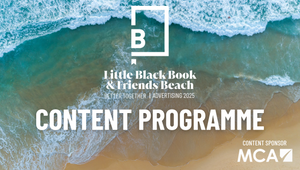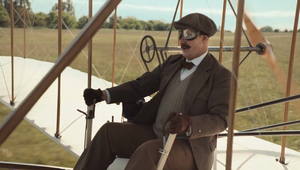
Behind the Work: The Process Behind PEDIGREE’s Powerful Promotion for Helping Homeless Dogs

Despite the fact that shelters are often the first place potential dog-owners look in their quest for a new pet, less than 40% in the US and less than 30% in Europe actually opt to adopt. In part, this is due to stigma and the assumption that somebody would only give their dog to a shelter because the dog is troublesome.
To combat this view, PEDIGREE has been working to eliminate dog-homelessness with their campaign: “Shelters are full of good dogs. They just need good homes.” This continued recently with the release of two videos that use the non-cynical view of young pet owners to demonstrate the potential for those who can move past their initial stigma.
LBB’s Josh Neufeldt spoke to BBDO’s Fred Kovey and Eric Goldstein, as well as The Corner Shop’s James Rouse to discuss the creation of this campaign.
LBB> What was the brief like? And what did you think when you saw it?
Fred> The brief was to do something emotional around dog adoption. Sounds easy. But it’s really hard because a lot has been done already. We actually joined the process a bit later and were lucky enough to have an idea that resonated.
LBB> The idea of telling audiences that there are lots of great dogs in shelters - through the naivety of a child’s mind - is an interesting approach. What was the inspiration behind that approach?
Fred> The idea to tell these stories from a child’s perspective came later. The initial spark was a personal experience. My wife and I had adopted a shelter dog named Dogby. She was like 12 years old, had bad teeth, an enlarged heart—basically she was a dog no one wanted. But, after getting to know her, I loved her so much that I found myself saying, “Man, how could anyone have given this dog up?” So, that was the initial inspiration. But then it evolved to having the main character be a kid, because it just gave us license to have these imaginary stories be more fanciful and amazing and weird.
LBB> James, at what stage was the script when you first saw it? And why was it something that appealed to you?
James> The creatives, Eric and Fred had written a brilliant idea. A child doesn’t understand why anyone would have given up their beautiful adopted dog, so they imagine a fantastical story that makes sense to them. The child’s endline “I mean why else would someone give up the greatest dog in the world” sums it all up brilliantly. Eric and Fred created a charming, imaginative world that was irresistible to the storyteller in me.
LBB> How involved were you in the narrative process? How did you bring your own vision to the story?
James> It’s my job to add the details to their story. Eric and Fred wrote a brilliant script. I then fleshed out the characters and the worlds they lived in. As part of my process, I wrote back stories for each character, details that help inform tiny details of what ended up on screen, whether it’s Boris [the Vampire] who’s lonely on account of being the only local vampire who’s a committed vegan, or the astrologer being an eccentric Austrian baroness who lives in the castle’s observatory, shunning the grand rooms of her baronial seat.
LBB> What was the casting process like - both for the actors and the dogs? What were you looking for?
James> I always work very hard with my actors, so we really get into what makes their characters tick. Even when there’s little dialogue or interaction with other humans, I’ve found it makes a massive difference in their on-screen performance. My actors will know everything about who their character is and why they’re doing what they’re doing. It’s something we’ll have arrived at together.
LBB> This campaign was done with the goal of ending stigma. But a big theme is also the idea that the initial owner’s circumstances can often create situations that force adoption. What was the strategic thinking behind that element of the campaign?
Fred> I think that element comes out more in the digital and social work, which are more about the real reasons people give up dogs. With the films, we really just wanted to tap into that emotional truth, that when you adopt a shelter pet, you struggle to imagine how anyone could have given them up.
LBB> With regards to the vampires and spaceship narratives, what was the writing process like? What inspired these particular subjects?
Eric> The alien story came first. It felt like a good story to represent the idea that the owner really didn’t want to give up their dog, but circumstances beyond their control forced them to be separated.
From there, we tried thinking of lots of other stories where we really pushed ourselves to think of different fantastical characters that kids might think up. Some of the stories skewed more funny. But we ultimately landed on a story about a vampire and his dog Sandy, who one day realises that, because he is a creature of the night, he has been inadvertently keeping his dog from playing with other dogs during the day. We fell in love with that idea because it showed another side to the adoption story - that some owners come to the decision to put their dogs up for adoption because it’s in the best interest of the dog. Even if they are heartbroken by the decision.
LBB> Why was James Rouse the right director to bring your vision to life?
Eric> We have been big fans of James’ work for many years now. He’s such a great storyteller. A lot of his work is hilarious. But he has also done some genuinely heartbreaking and impactful work, like the ‘Hope’ spot he did for the Red Cross. That balance of playful humor and heartbreak is what we were striving to achieve with this work.
Fred> So many reasons. He’s really an amazing all-around director. What he did with the locations and the casting and the way it’s shot -all just flawless, in my opinion. But I think the aspect of what he brought to it that surprised me most was how seriously he took the emotional truth of the performances. He would literally spend 20 minutes talking through the character’s emotional state with each actor - and this is during the casting process - just to make sure we were getting totally real, totally authentic performances. I don’t think many directors would do that. But it made a difference for sure.
LBB> In general, what was the production process like? How long were you shooting for? Were there any particularly memorable moments?
James> I loved this shoot from start to finish. It was a brilliant idea, with a story that was playing to my strong points and what I love doing. We shot for five days in Latvia, based out of Riga. It was a little trickier than normal due to Covid. A highlight were the locations. The amazing Baldone observatory - a Soviet era observatory - built in 1959 and still operational. And this amazing strawberry farmer’s house that we used for Vampire, complete with spooky turrets. It’d been in the family for multiple generations, didn’t have any running water and was heated by this enormous iron furnace in the centre of the home.
LBB> How much was done in post? In general, what was the post production process like?
James> Framestore, under the post-supervision of Martin Lazaro, did a really lovely job creating the alien spaceship for Astrologer. The objective was to get into the mind of a child for its creation, so we referenced classic spaceships of cartoons and illustrations, then gave it a twist to suit our story with it’s own ‘dog tractor beam’.
LBB> With regards to the aesthetics and colour grade of the films, what were your main aims and ambitions?
James> Although this might sound clunky, our characters lived such colourful lives, it felt right that we had a vivid colour palate. Joost van Gelder did a brilliant job shooting it and Beau Leon from Framestore LA did a fabulous job in the grade.
LBB> The soundtrack really enhances the themes and emotions of the films. What kind of conversations did you have with the music company?
James> Bill, our editor [from Work Editorial], did a brilliant job finding guide tracks. We used his choice of music for Vampire [Valse Sentimentale by Tchaikovsky], then used the fabulous composer Oli Julian to write something for Astrologer, using Bill’s guide to set the tone.
LBB> Shooting with animals is known to be a challenge! How did you deal with it?
Eric> Dogs and kids are always a challenge. With dogs there is only so much you can do to get them to perform. With the kids though, we were fortunate enough to have a director who was passionate about taking the time to find just the right actors to tell these stories well. I’ve never worked with a director who was more skilled in the art of getting good performances out of kids. A lot of it came down to James really being able to pinpoint the nuances in their performance that needed to shift in order for the delivery to be convincing. And then knowing just what to say to them to get them to step into the characters and really believe that it was their own dogs that they were talking about. It was impressive to watch.
But yes. When you combine small children with disobedient dogs, things can get… how do I say this… challenging! One of the dogs in the spots ended up being much more difficult to handle on set than we had imagined. It’s always tricky filming dogs. You never quite know what to expect. But fortunately, between James, the trainer and the production team, we were able to get the shots and the warmth from the dog that we needed.
James> The dogs can be a little trickier. We filmed these spots in Latvia and I was working with dogs and handlers I hadn’t worked with before. One of the dogs wasn’t as trained as we’d hoped and was very tricky on set. Thankfully, Bill, the editor, did a marvellous job at hiding this and I’m already beginning to forget how difficult it was!
LBB> What other challenges did you face with this project and how did you overcome them?
Fred> Hmmm… this one was pretty smooth sailing overall. Although I’m sure James would disagree because he had to deal with some pretty daunting Covid logistics. I’d say the main challenge was knowing that these could be special and just not wanting to mess them up.
James> I learnt that your on-set dog can never be over-trained! And that dog elevators are expensive to create and can break down easily.
LBB> What has the reception of the campaign been like?
Fred> People seem to really love the spots. But I guess it’s too early to say how many adoptions they’ll lead to. Hopefully lots!
LBB> Any parting thoughts?
Fred> I know everyone says this, but our PEDIGREE clients deserve so much credit for making these and for making them great. It’s not a coincidence that they make so much great work. They’re amazing at what they do.
James> Yes! We were given so much trust on this job and it always pays off. The client and agency were amazing. They trusted us to hire the right people, allowed us to work hard for them to make the best films possible. It created a brilliant atmosphere of a unified team working for one common goal.















